This is a page within the www.staffshomeguard.co.uk website. To see full contents, go to SITE MAP.
MEMORIES
AND INFORMATION - WORCESTERSHIRE
12th
WORCESTERSHIRE (WARLEY) BATTN.
- A SOUVENIR OF
FRIENDSHIP -
(A Brief History of the
Battalion)
|
At the time
of stand-down at the end of 1944, the Battalion
produced a commemorative booklet - A Souvenir of
Friendship - providing a brief history of the
unit and a record of many of the faces of those who
had served within it. Much of the information in it
was published in a series of articles in the
Black Country Bugle in the spring of 2015.
This is what
the booklet
contained.
A BRIEF HISTORY
OF THE BATTALION.
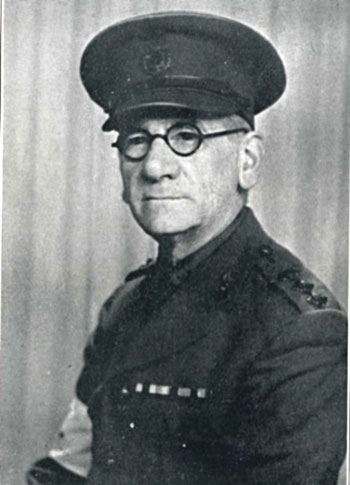 WHEN
the call came over the "air" on May 14th, 1940
asking for Volunteers to enrol for the Defence
of their Homes, there was created in the
OLDBURY, WARLEY, QUINTON, BLACKHEATH and
HALESOWEN Districts an L.D.V. Organisation
under the command of the then
Capt. T. S.
Lancaster, M.C.
(right).
Within a few weeks the number of Volunteers
had exceeded all expectations and by the time
the Prime Minister announced the change of
name from L.D.V. to Home Guard, this local
force had become too unwieldly for one
command. From it emerged the present
5th
Worcestershire (Halesowen) Bn.,
8th
Worcestershire (Oldbury) Bn., and
12th
Worcestershire (Warley) Bn., each over 1,000
strong. WHEN
the call came over the "air" on May 14th, 1940
asking for Volunteers to enrol for the Defence
of their Homes, there was created in the
OLDBURY, WARLEY, QUINTON, BLACKHEATH and
HALESOWEN Districts an L.D.V. Organisation
under the command of the then
Capt. T. S.
Lancaster, M.C.
(right).
Within a few weeks the number of Volunteers
had exceeded all expectations and by the time
the Prime Minister announced the change of
name from L.D.V. to Home Guard, this local
force had become too unwieldly for one
command. From it emerged the present
5th
Worcestershire (Halesowen) Bn.,
8th
Worcestershire (Oldbury) Bn., and
12th
Worcestershire (Warley) Bn., each over 1,000
strong.
Capt. T. S.
Lancaster, M.C. assumed command of the TWELFTH
and when commissioned rank was given to
Officers he became the first Lieut.-Colonel
and selected as his Second in Command,
Major W. P. Homes
(below),
already well known in Oldbury and the county
for his public activities.
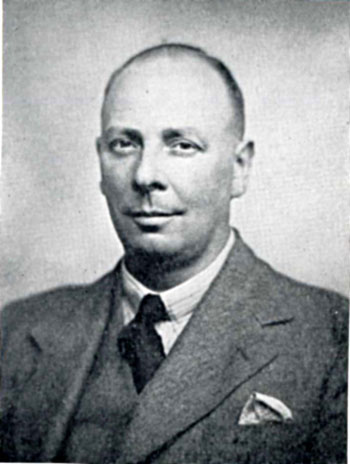 In
the beginning, Battalion Headquarters was at
the Drill Hall, Langley, but in November, 1941
it was moved to a more central position in
Perry Hill Road, Quinton, where it remained
until the "Stand Down." The first recognition
of the Home Guard as a Military Unit was the
appointment to each Battalion of a Regular
Army Captain as Adjutant and Quartermaster,
the appointment in the TWELTH being taken up
by Capt. H. S. Kemshead, already an Officer in
"B" Company and who was called up from the
Emergency Reserve. In March, 1942, an Army
P.S.I, was attached to the Battalion to assist
in training and in July an additional Regular
Captain was appointed to relieve the Adjutant
of the "Q" duties. This appointment was taken
up by Capt. F. J. Holder, also one of the
original L.D.V. and a member of "C" Company of
the TWELFTH, who left the Battalion on posting
to Civil Affairs abroad in September, 1943, to
be succeeded by Capt. A. Stephens of many
years' experience in the Field Force. In
the beginning, Battalion Headquarters was at
the Drill Hall, Langley, but in November, 1941
it was moved to a more central position in
Perry Hill Road, Quinton, where it remained
until the "Stand Down." The first recognition
of the Home Guard as a Military Unit was the
appointment to each Battalion of a Regular
Army Captain as Adjutant and Quartermaster,
the appointment in the TWELTH being taken up
by Capt. H. S. Kemshead, already an Officer in
"B" Company and who was called up from the
Emergency Reserve. In March, 1942, an Army
P.S.I, was attached to the Battalion to assist
in training and in July an additional Regular
Captain was appointed to relieve the Adjutant
of the "Q" duties. This appointment was taken
up by Capt. F. J. Holder, also one of the
original L.D.V. and a member of "C" Company of
the TWELFTH, who left the Battalion on posting
to Civil Affairs abroad in September, 1943, to
be succeeded by Capt. A. Stephens of many
years' experience in the Field Force.
In May, 1941 the
appointment of the first Battalion Specialist
Officers was the origin of what in August,
1942 became Headquarters Company, composed of
Signal and D.R., Pioneer, Intelligence, and
Administrative Platoons, the latter consisting
of Cooks, Medical, Gas and Transport Sections.
Each Platoon and Section of this Company was
trained and operated by its own Specialist
Officer, and all proved their keenness and
efficiency in the many District, Garrison,
Sector and Battalion Exercises and in the
Training Camps during their three years'
existence.
In the early days
of L.D.V. and Home Guard the TWELFTH was
directly under the command of
General Sir
George Weir, K.C.B., C.M.G., D.S.O., followed
by Colonel W. H. Wiggin, C.B., D.S.O., T.D.,
Zone Commanders, Worcester, but during 1941 it
was absorbed into the BIRMINGHAM DEFENCE
SCHEME and from that time came under the
Birmingham Garrison Commander for training and
operations, and Worcester for Administration
and Equipment only. Serving a dual Higher
Command has not been an easy task, but the
TWELFTH has done so successfully and has stood
high in the estimation of both Commands. From
September, 1941 until the Stand-Down the
Battalion has been Home Guard as a Military
Force has taken place.
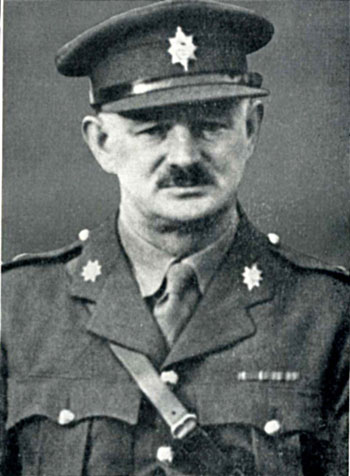 Lieut.
Colonel T. S. Lancaster, M.C. resigned in
July, 1941 on reaching the Age Limit and was
succeeded by Lieut.
Colonel T. C. Fillery,
(left),
then O.C. "C" Company. Major W. P. Homes
resigned for health and business reasons in
August, 1942 and Major W. J. Balderstone
(below),
O.C. "D" Company
assumed the Lieut.
Colonel T. S. Lancaster, M.C. resigned in
July, 1941 on reaching the Age Limit and was
succeeded by Lieut.
Colonel T. C. Fillery,
(left),
then O.C. "C" Company. Major W. P. Homes
resigned for health and business reasons in
August, 1942 and Major W. J. Balderstone
(below),
O.C. "D" Company
assumed the
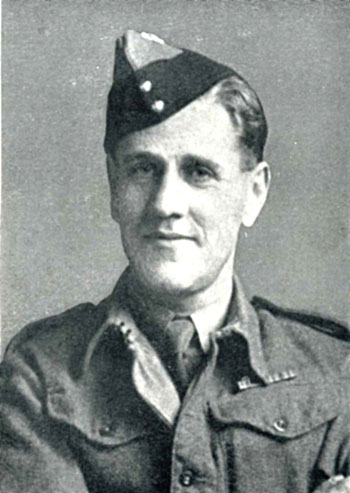 appointment
of Bn. Second in Command, until taking over
the Command of the TWELFTH in June, 1944 when
Lieut. Colonel T. C. Fillery was posted to the
8th Worcs. Bn. Major Balderstone was
then promoted to the rank of Lieut. Colonel
and appointed Major A. E. Church
(below), O.C. "B"
Company as his Second in Command. appointment
of Bn. Second in Command, until taking over
the Command of the TWELFTH in June, 1944 when
Lieut. Colonel T. C. Fillery was posted to the
8th Worcs. Bn. Major Balderstone was
then promoted to the rank of Lieut. Colonel
and appointed Major A. E. Church
(below), O.C. "B"
Company as his Second in Command.
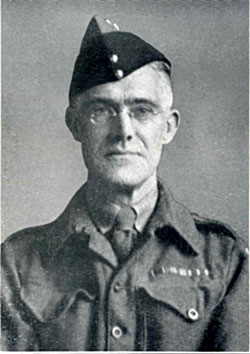 During its
lifetime, the TWELFTH has achieved many
successes. In New Year and Birthday Honours it
has had its share of Meritorious and Good
Service Awards; in Garrison Examinations for
Signals and Intelligence personnel 95% of
these specialists have been granted
Certificates and many Officers and N.C.O.s
have collected Gas Instructors Awards in
Birmingham Courses of Instruction. The
Battalion has also raised large sums for
Charity, notable efforts being nearly £8,000
for the Worcestershire Regiment P.O.W. Fund in
less than 8 months; over £2,000 in two days
for one Borough's Salute the Soldier Week, and
over £6,000 for another a few weeks later. During its
lifetime, the TWELFTH has achieved many
successes. In New Year and Birthday Honours it
has had its share of Meritorious and Good
Service Awards; in Garrison Examinations for
Signals and Intelligence personnel 95% of
these specialists have been granted
Certificates and many Officers and N.C.O.s
have collected Gas Instructors Awards in
Birmingham Courses of Instruction. The
Battalion has also raised large sums for
Charity, notable efforts being nearly £8,000
for the Worcestershire Regiment P.O.W. Fund in
less than 8 months; over £2,000 in two days
for one Borough's Salute the Soldier Week, and
over £6,000 for another a few weeks later.
Its Officers raised
£150 in three days as a gift to the Admiralty
towards a new H.M.S. Repulse when the famous
ship of that name was sunk, and in War Weapons
and Wings for Victory Weeks the Battalion did
its full share.
During the summer
months of 1943 and 1944 week-end Camps were
held at Shrawley and each week-end from April
to September an average of 100 enjoyed Camp
life and training in delightful new
surroundings. Here the cooks came into their
own, providing from ordinary rations many
varied and delightfully cooked meals under the
very able direction of the "Q" Staff.
The Pioneer Platoon
apart from its consistent good work in
operations and camp, voluntarily took up
training in Heavy Rescue and First Aid under
tuition from the Harborne A.R.P. Training
Centre; and after an abridged course of a few
weeks only, received high commendation from
the Birmingham City A.R.P. Authorities. This
training was additional to the Home Guard
parades, and their usual keenness and
efficiency was maintained in both spheres of
activity. A number of Pioneers and also in
their own time studied explosives and
demolitions under the guidance of Officers of
the TWELFTH whose civilian occupation was
connected with such subjects, and these Home
Guard explosive experts assisted in a number
of demolitions of buildings and stacks in the
Birmingham Area. They also supplied the
welcome effects used in many of the Training
Exercises carried out by the Battalion,
thereby giving realism to what might otherwise
have been very ordinary mock battles.
|
IMAGES OF THE
BATTALION'S COMPANIES
"A" Coy.
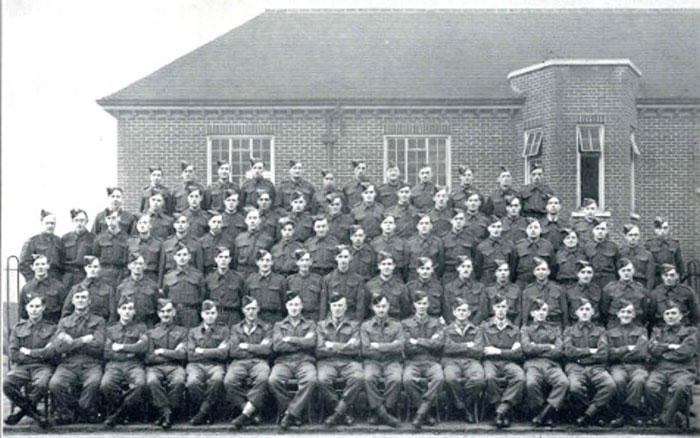
showing officers, N.C.O.s and men. The
location is the T.A. Centre at Langley.
Click on the image to see a
magnified version.
"B" Coy.
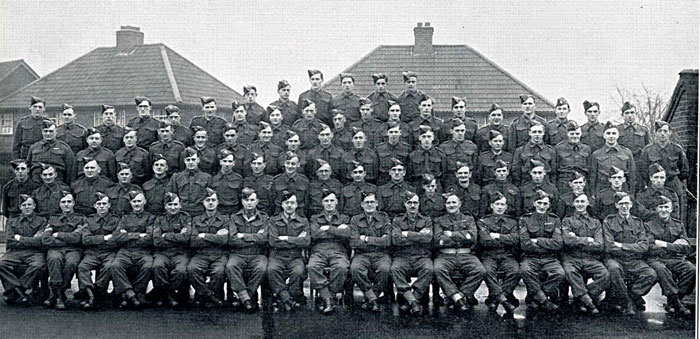
showing
officers, N.C.O.s and men, at George Road
School.
Click on the image to see a
magnified version.
"C" Coy.
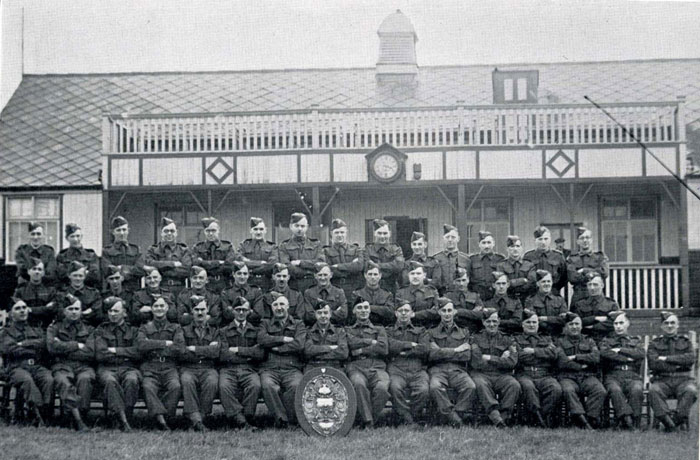
showing officers, N.C.O.s and men; the
small number suggests a group from within "C"
Company responsible for winning the impressive
shield in a now forgotten competition. The
location is the Chance and Hunt cricket
pavilion in Dog Kennel Road.
Click on the image to see a
magnified version.
"D" Coy.
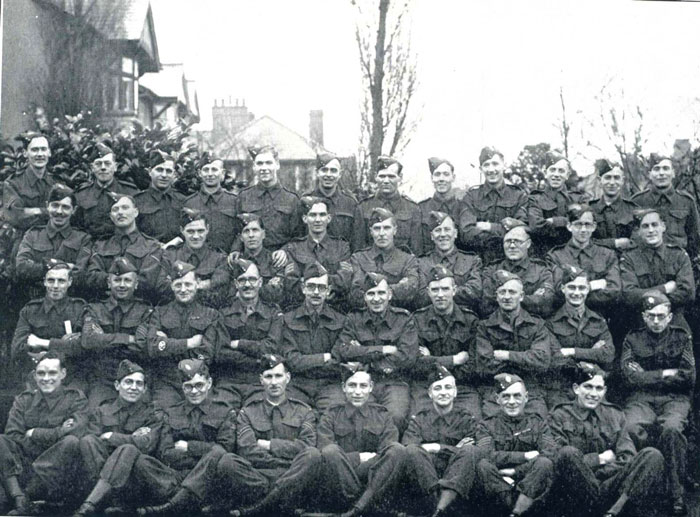
showing officers and N.C.O.s. The
location is somewhere in Lapal, Quinton. It is
not possible to identify exactly where; but
this unit did meet at the Lapal School and the
Methodist Church, although their HQ was at
the
Danilo cinema.
Click on the image to see a
magnified version.
"E" Coy.
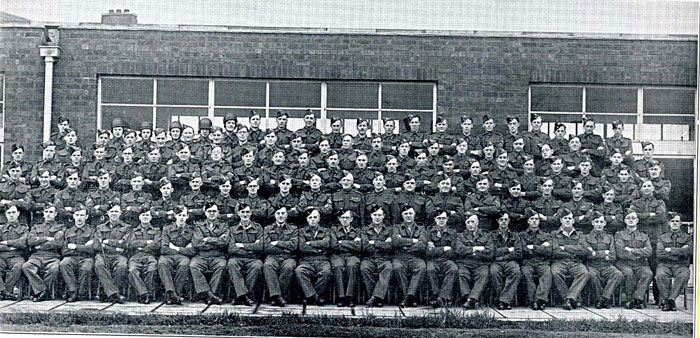
showing officers, N.C.O.s and men at
Brandhall School.
Click on the image to see a
magnified version.
HEADQUARTERS (Officers)
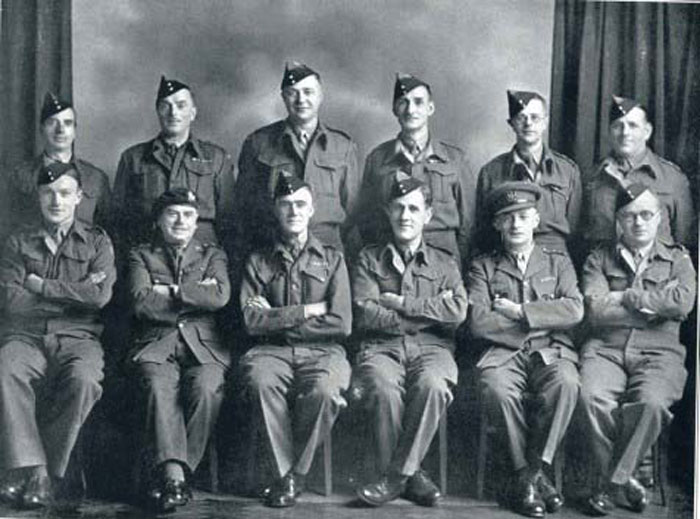
BATTALION OFFICERS
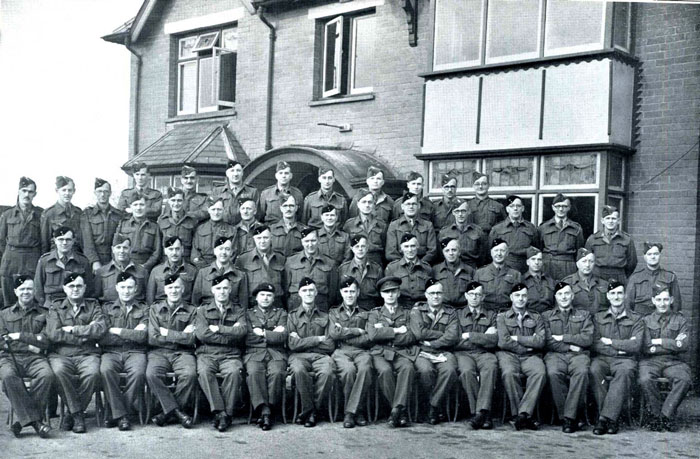
Click on the image to see a
magnified, fully captioned version.
This photograph was taken on Sunday,
15th October 1944 at a house named
"High Tor".
This was the Battalion HQ and was located on
Perry Hill Road, Warley
between Tame Hill and Perry Hill Crescent and
opposite Forest Road.
One has to assume
that "High Tor" was, for one reason or
another, largely unused in 1940 and was
therefore requisitioned by the Home Guard as a
suitable Battalion HQ. Memories of the house
survive from immediately prior to, or after,
the outbreak of war but before the arrival of
the Home Guard. A visitor to this website,
living nearby in Forest Road, describes being
taken for dancing lessons on the ground floor
of the house in the left hand reception room
where a piano had been installed. There is a
dim memory that perhaps the upper floor was
still occupied. Later, during the Home Guard
era, there may have been earth fortifications
in the gardens of the house.
(In
Forest Road
there lived at least one member of the local
Home Guard who may or may not have been based
at "High Tor": he was
Sgt. Sam Bell,
a family man with three daughters.)
N.B. Most of the
above Company images show numbers of men which
are fewer than might have been expected. There
are several possible explanations for this,
including the particular circumstances when
the photograph was taken - perhaps many men
were unavailable, perhaps it was a selected
group for one reason or another. Another
factor may have been the reduction in the
numbers of these traditional infantry Home
Guard battalions when many Home Guards were
transferred to local anti-aircraft duties
during 1942 and 1943 and thus effectively left
their original Battalion - the strength of the
latter when acting in a solely infantry role
would have been between
1000 and 1500 men. |
ACKNOWLEDGEMENTS
Staffshomeguard
is most grateful to
the
"Black Country Bugle" newspaper and Mr.
Dan Shaw for providing information previously
published in that newspaper and generously
permitting its republication here; to Roy Bates
of the Warley History Society for information,
including locations of the group images; to
Michael Condon for early memories of "High
Tor"; to David Slade for images; and
to David Baker for other information.
FURTHER
INFORMATION
Further information about the Home Guard in
Worcestershire is contained elsewhere in
various parts of this website. To view the
Worcestershire summary page, please use the
Mems-Worcs
link below.
And if you
can add anything to the history of the
Worcestershire Home
Guard, please contact staffshomeguard via the
Feedback link.
Other
12th
Worcestershire (Warley) Battalion
pages in this website:
The
Danilo Platoon and Ken Cradock
Harry Mac Leod Kay
Leslie Pierson
Magnified Group images
|
x130 January 2016,
updated October 2017 |
|